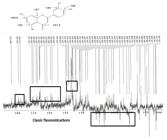ABSTRACT.
Poincianella pyramidalis (catingueira) is a endemic plant of the Caatinga, selected by animals grazing on native pasture. With the aim of evaluating characteristics indicative of its nutritional quality, 10 plants were selected and identified, sampled at five different ages, were used to determine dry matter (DM), crude protein (CP), neutral detergent fibre (NDF), mineral matter (MM), DM degradability (Deg DM), NDF degradability (Deg NDF) and in situ and in vitro leaf-tissue degradability. Phytochemical prospection was performed, and 1H and 13C nuclear magnetic resonance applied to detect the presence of secondary compounds. The data were submitted to analysis of variance and Tukey’s test at 5%, and correlation analysis was carried out on the variables for leaf maturity in days. The levels of CP, NDF and Deg NDF showed a negative correlation with the increases in leaf age. Leaf-tissue degradation was restricted due to a physical barrier developed in the leaf fragments, which can be attributed to plant defence mechanisms. The in situ degradability of the cell wall components decreased with the increase in leaf age. The high levels of tannins and lignin, and the strong presence of flavonoids, should be considered for their anti-nutritional and pharmacological potential.
Keywords:
degradability; native forage; nutrients; plant defence; tannins

 Thumbnail
Thumbnail
 Thumbnail
Thumbnail
 Thumbnail
Thumbnail


